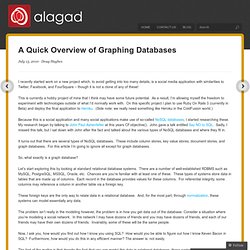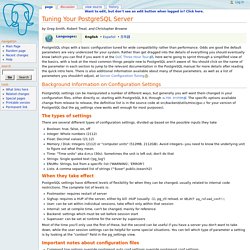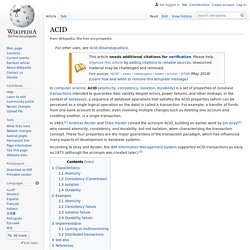

Programming, politics, & other religious issues. PostgreSQL Hardware Performance Tuning. POSTGRESQL is an object-relational database developed on the Internet by a group of developers spread across the globe.

It is an open-source alternative to commercial databases like Oracle and Informix. POSTGRESQL was originally developed at the University of California at Berkeley. In 1996, a group began development of the database on the Internet. They use email to share ideas and file servers to share code. POSTGRESQL is now comparable to commercial databases in terms of features, performance, and reliability.
There are two aspects of database performance tuning. To understand hardware performance issues, it is important to understand what is happening inside the computer. You can see that storage areas increase in size as they get farther from the CPU. Moving information between various storage areas happens automatically. CPU registers and the CPU cache cannot be effectively tuned by the database administrator. You might think this is easy to do, but it is not.
A Quick Overview of Graphing Databases - Alagad Ally. I recently started work on a new project which, to avoid getting into too many details, is a social media application with similarities to Twitter, Facebook, and FourSquare – though it is not a clone of any of these!

This is currently a hobby project of mine that I think may have some future potential. As a result, I’m allowing myself the freedom to experiment with technologies outside of what I’d normally work with. On this specific project I plan to use Ruby On Rails 3 (currently in Beta) and deploy the final application to Heroku. (Side note: we really need something like Heroku in the ColdFusion world.) Because this is a social application and many social applications make use of so-called NoSQL databases, I started researching these.
It turns out that there are several types of NoSQL databases. So, what exactly is a graph database? Let’s start exploring this by looking at standard relational database systems. Now, I ask you, how would you find out how I know you using SQL? Documentation. Skip site navigation (1) Skip section navigation (2) Peripheral Links Documentation There is a wealth of PostgreSQL information available online.

This section contains current and archived manuals for PostgreSQL users, as well as frequently asked questions. You can learn what's new in the latest release, and view a listing of books written about PostgreSQL (some of which are available in their entirety online). Online Manuals 9.5 (with/without comments) 9.4 (with/without comments) 9.3 (with/without comments) 9.2 (with/without comments) Tuning Your PostgreSQL Server. By Greg Smith, Robert Treat, and Christopher Browne PostgreSQL ships with a basic configuration tuned for wide compatibility rather than performance.

Odds are good the default parameters are very undersized for your system. Rather than get dragged into the details of everything you should eventually know (which you can find if you want it at the GUC Three Hour Tour), here we're going to sprint through a simplified view of the basics, with a look at the most common things people new to PostgreSQL aren't aware of. You should click on the name of the parameter in each section to jump to the relevant documentation in the PostgreSQL manual for more details after reading the quick intro here. There is also additional information available about many of these parameters, as well as a list of parameters you shouldn't adjust, at Server Configuration Tuning. Background Information on Configuration Settings The types of settings When they take effect Important notes about configuration files autovacuum.
ACID. Set of properties (atomicity, consistency, isolation, durability) of database transactions intended to guarantee validity even in the event of errors, power failures, etc.

According to Gray and Reuter, IMS supported ACID transactions as early as 1973 (although the term ACID came later).[3] Characteristics[edit] The characteristics of these four properties as defined by Reuter and Härder are as follows: Atomicity[edit] An example of an atomic transaction is a monetary transfer from bank account A to account B. Consistency[edit] Isolation[edit] Durability[edit] Examples[edit] The following examples further illustrate the ACID properties.
CREATE TABLE acidtest (A INTEGER, B INTEGER, CHECK (A + B = 100));